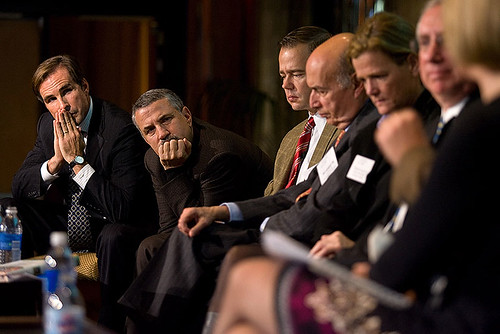51łÔąĎÍř alumni, parents, and faculty harnessed their intellectual resources in New York last week, at the university’s first Energy Summit sponsored by the Presidents’ Club.
ABC’s Bob Woodruff ’83, P’13 moderated a panel discussion featuring six alumni who represented diverse perspectives on the energy field: journalist and Alaska resident Elizabeth Arnold ’82; energy investor Bob Gold ’80; London-based energy policy advisor and attorney Jane Kozinski ’82; wind entrepreneur David Mortenson ’88; Edgar Lampert ’62, P’10, a real estate developer committed to sustainable building; and Bruce Selleck ’71, Harold Orville Whitnall Professor of geology at 51łÔąĎÍř.
But first, keynote speaker Thomas Friedman, New York Times columnist and Pulitzer Prize-winning author of Flat, Hot and Crowded and other best sellers, warmed up the crowd.
Innovation, he said, is the only way to fuel a true green revolution. “How do we stimulate 10,000 innovators in 10,000 green garages, trying 10,000 different things, 1,000 of which will be promising, 100 of which will be way cool, and maybe two will give us sources of abundant, cheap, clean, reliable energies?”
 |
| ABC’s Bob Woodruff ’83, P’13 (left) moderates a panel discussion about energy featuring six alumni. Next to him is keynote speaker Thomas Friedman, New York Times columnist and Pulitzer Prize-winning author. (Photo by Lorenzo Ciniglio) |
51łÔąĎÍř experts agreed on the power of innovation; yet, as Friedman had, they also stressed the importance of price in terms of stimulating both investment and consumer demand for clean energies — from wind turbines, solar, and hydropower, to clean coal, the smart grid, and natural gas.
Arnold said she sees the power of innovation firsthand in oil-dependent Alaska. “In places where they are still hunting whales and seals, where they still use skin boats, there are wind farms going up.” The wind technology, she said, is being developed using dollars that are earned from fossil fuels. “The symbol can’t be lost.”
Gold said that oil companies will clamor to help once they have a strong profit incentive. “If we want to cure cancer, we wouldn’t think of excluding the drug companies. But we’re trying to cure an energy problem while excluding the energy companies.”
|
Mortenson, whose company is the largest design-builder of wind energy in the United States, confirmed that price incentives gave European companies a head start in turbine innovation.
“Unless you have a balance of either incentives, through the production tax credit, or the pricing of carbon on polluting industries, you have no price incentive and you don’t have any stability or predictability. We are getting our proverbial rear ends kicked,” said Mortenson.
Finally, bringing the debate closer to 51łÔąĎÍř, Selleck advocated for a source of energy that is abundant below campus, in the Marcellus Shale. “Natural gas is the perfect intermediate fuel,” Selleck said, “especially for transportation.”
What, then, does the future hold for the science students whose energy is spent above ground at 51łÔąĎÍř?
“There’s so much geology needed right now,” Selleck said, “more than ever before. With the expansion of natural gas development in this country, there are jobs available in spite of the economy and in spite of the low cost of natural gas. Companies know the demand is going to be there.”